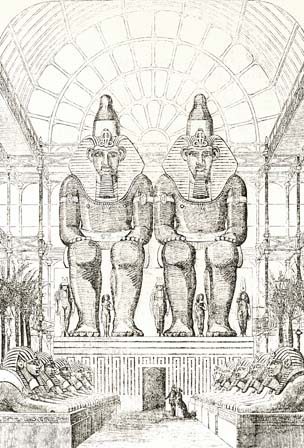B.21 - The
Palace of the People - Sydenham 1854
by Jan Piggott, Keeper of the
Archives, Dulwich College
Prelude to an Exhibition in 2004
to mark the 150th anniversary of the Sydenham Crystal Palace. it will
be held at the Dulwich Picture Gallery and a book will be published
to complement the exhibition.
Background
Just above Dulwich, the Crystal
Palace stood on the horizon for eighty-two years, a glittering crown
to the bosky Sydenham Hill. Opened by Queen Victoria on June 10th,
1854, the Palace was on a colossal scale: it took double the amount
of glass used by Paxton for the Crystal Palace at Hyde Park in 1851.
For its first thirty years the Palace and Gardens drew an average of
two million visitors annually. What went on at this 'Palace of the
People'? What did it look like inside and out?
The interior nave was originally a
Winter Garden with extraordinary botanical displays and statuary. To
the sides were found most wonderful and at times bizarre displays of
architecture, industry, ethnography and natural history. By its
charter the Crystal Palace was bound to keep up the 'high moral and
social tone' of the Great Exhibition of 1851, and there was much
instruction as well as entertainment.
The vast sloping park was laid out
with terraces, elaborate formal gardens and informal English
landscape gardening. The waterworks fountains, water temples and
cascades were intended to surpass Versailles; the main jet was higher
than Nelson's column, and the system could pump 120,000 gallons a
minute. The Park was even educational: the features included
'geological illustrations' and a prototype of the 'theme park'-
twenty-nine life-size dinosaurs and other prehistoric
creatures.
The building and contents reflected
the interests of its designers. Sir Joseph Paxton constructed his
famous modular building of prefabricated units of cast iron and
glass; Ruskin from his house on the nearby Herne Hill jeered at the
'cucumber frame' between the 'two chimneys' of Brunel's water-tower.
Paxton's great botanical knowledge and enthusiasm garnered rare
plants into the grandest conservatory in history, and his study of
garden history shaped the Park. Paxton's building survived until the
great fire of 1936 as a monument to and a symbol of the Victorian
age; by this date it had also become an icon of the architectural
Modern Movement, both English and continental.
|

|
Inside the Palace the
academic knowledge and originality of Matthew Digby Wyatt
and particularly of Owen Jones, the 'colour king', resulted
in the polychromatic architectural structures, resembling
film sets, of the Fine Art Courts. These taught a sequence
of the main architectural styles of the world, seen most
ambitiously in the Assyrian and Egyptian Courts, which
included brick and plaster reproductions of the Aboo Simbel
figures, sixty-five-feet high, showing the seated Rameses
the Great; these were consumed in the North Transept fire of
1867.
The illustration is taken
from the catalogue of the exhibition
"The Crystal
Palace at Sydenham and the Architectural Courts"
held in the Wodehouse
Library at Dulwich College on 18 January to 18 February
1988.
|
The Exhibition
2004
The exhibition with its wealth of
contemporary paintings, original photographs and engravings makes
possible an imaginary visit to the Palace and Gardens. The relation
to the 'Parent Building' at Hyde Park and to the Great Exhibition is
demonstrated; in general the 1851 exhibition is well known, but the
extraordinary richness and range of the displays and activities at
Sydenham are mostly unfamiliar.
The exhibition shows memorabilia
from the entertainments up at the Palace: musical premieres and (from
1859) the famous Handel festivals, sports and the Empire exhibition
of 1911 held out of doors. The air space above the Park was used most
imaginatively for fireworks displays with the strange art form of
elaborate coruscating set pieces representing scenes such as battles
or Antarctic exploration, for balloon ascents and for Blondin to cook
an omelette on a high wire. The Palace was a Naval Depot during the
First World War, and became the obvious popular setting for brass
band festivals' cat shows, pantomimes, mass baptisms and boxing
matches. Spectacular film footage shows the fire of 30 November,
1936.
|
The exhibition places the
Crystal Palace in the context of social and cultural
history, of national and local history, of the history of
museums, of public education in architecture, and of the
history of taste; it raises issues of commercialised
leisure.
|

|
Ed: Jan Piggott, at Dulwich College, is preparing an exhibition in
2004 on the Sydenham Crystal Palace to mark the 150th
anniversary of its opening on Sydenham Hill. The exhibition will be
held at Dulwich Picture Gallery and there will be a book to
complement the occasion.
Top
of page; Return
to Background Index

17/11/02 Last Updated
17/11/02

